I arrived promptly at six o’clock at the Central Branch of the Kansas City Public Library, after dropping my vanpool riders off at their after-work destinations. I found the first floor of the Library nearly abandoned. I reviewed the signage for scheduled daily events and determined that Antietam panel occupied the fifth floor in Helzberg Hall. I took the elevator to the top floor with several other likely audience members.
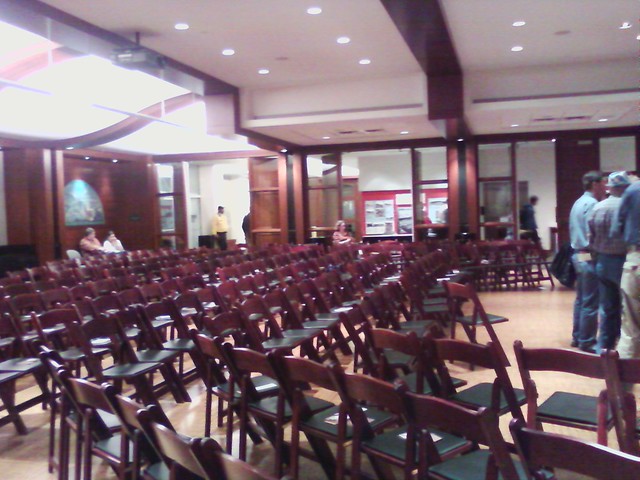 I followed the others to the wine line, as the reception was already in full swing. I glanced at the lecture hall and noted most of the seating appeared to be taken. I cringed at the sight of the wooden folding chairs, knowing my back and posterior would be complaining painfully before the event concluded. I asked for some chardonnay, found a seat and took out my Nook Color to get check in via the Library’s free wifi internet.
I followed the others to the wine line, as the reception was already in full swing. I glanced at the lecture hall and noted most of the seating appeared to be taken. I cringed at the sight of the wooden folding chairs, knowing my back and posterior would be complaining painfully before the event concluded. I asked for some chardonnay, found a seat and took out my Nook Color to get check in via the Library’s free wifi internet.
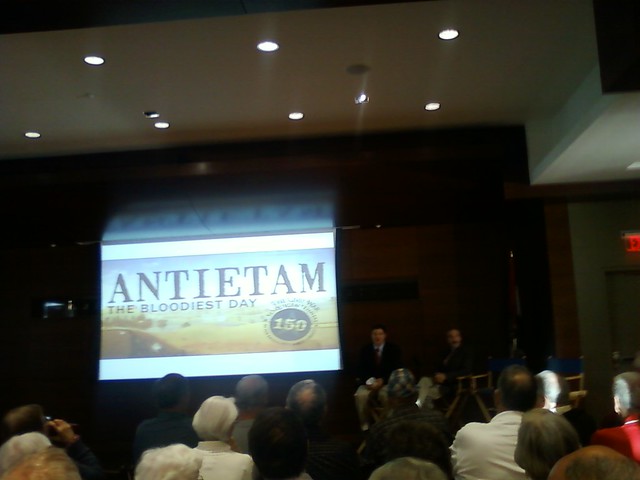 Soon after I finished my wine, the Executive Director of the Library, Crosby Kemper, and the four historians from the CGSC, took the stage. Director Kemper prefaced his panelist introductions with some background information on the Battle of Antietam, managing to connect himself to an ancestor, a Confederate General James Lawson Kemper, present at Antietam and later at Gettysburg (being the only non-professional military officer in the division that led Pickett’s Charge).
Soon after I finished my wine, the Executive Director of the Library, Crosby Kemper, and the four historians from the CGSC, took the stage. Director Kemper prefaced his panelist introductions with some background information on the Battle of Antietam, managing to connect himself to an ancestor, a Confederate General James Lawson Kemper, present at Antietam and later at Gettysburg (being the only non-professional military officer in the division that led Pickett’s Charge).
Director Kemper mentioned and recommended Landscape Turned Red by Stephen Sears for those who want to fully immerse themselve in the bloody battle. The Battle of Antietam may have been one of the least decisive battles of the Civil War, but the political repercussions allowed and encouraged Lincoln to release the Emancipation Proclamation five days afterwards.
A Misty, Moisty Morning . . .
Mr. Kemper introduced the panel leader, Ethan Rafuse, of the military history department of the U.S. Army Command and General Staff College at Fort Leavenworth. I had some difficulty deciphering everything being said by the various speakers, so I took copious notes and also did some research to find out more about the panelists. I discovered a blog post by Mr. Rafuse, published on the 150th anniversary of the battle, and much of the contents of that post mirrored his talking points. Mr. Rafuse previously spoke about the life and accomplishments of Thomas Jonathon ‘Stonewall’ Jackson at a Library event on June 7, 2012 (click here to listen to his lecture or watch the video from that event). His first comment upon receiving the microphone from Director Kemper humorously let us know that James Kemper’s brigade was driven from their position at the Battle of Antietam.
Mr. Rafuse set the stage for the discussion by drawing us into the battle through an eye witness first person account, via a primary source, a letter from Wilder Dwight to his mother, written on that fateful day in Maryland one hundred fifty years ago.
Near Sharpsburg. Sept. 17th 1862. On the field
Dear Mother,
It is a misty moisty morning. We are engaging the enemy and are drawn up in support of Hooker who is now banging away most briskly. I write in the saddle to send you my love and to say that I am very well so far —
He also related an interesting tale about a dog and his master, Werner von Bachelle. He completed his abbreviated recap of the Battle of Antietam and introduced the remaining three panelists (all links below to previous lectures include audio and/or video of the event):
- Lt. Col. (Ret.) Edward ‘Bud’ Bowie, speaking on behalf of the Confederates, currently writing Twenty-Five Battles That Changed the World. Earlier this year, Bud Bowie lectured on Confederate President Jefferson Davis, his miscalculations dooming the South economically despite victories on the battlefield.
- Dr. Gregory Hospodor, providing the Union response. This past spring, Dr. Hospodor discussed the Battle of Shiloh, explaining how the bloodiest fighting in the Civil War brought home to both sides the grim reality of the conflict.
- Terry Beckenbaugh, discussing the Emancipation Proclamation. He provided some of the first lectures for the Library’s Civil War sesquicentennial series, including this one from last October on The First Year of the Civil War in Missouri.
First Six Months of 1862 in the South
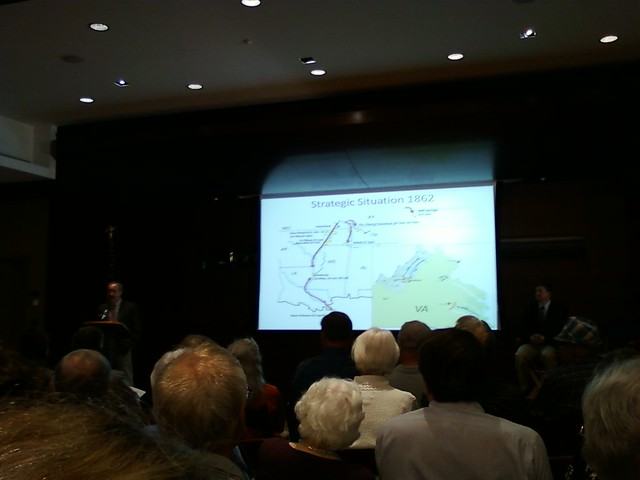 Bud Bowie began his short ten minute talk with the Confederate strategic situation in 1862 leading up to the Battle of Antietam. The South had lost control of most of their waterways and portions of Kentucky and West Virginia. Robert E. Lee was not the commander of the Conference Army at this time. He was tasked with securing West Virginia, which he failed to accomplish. He became the military adviser to Jefferson Davis, who was not amenable to Lee’s advice.
Bud Bowie began his short ten minute talk with the Confederate strategic situation in 1862 leading up to the Battle of Antietam. The South had lost control of most of their waterways and portions of Kentucky and West Virginia. Robert E. Lee was not the commander of the Conference Army at this time. He was tasked with securing West Virginia, which he failed to accomplish. He became the military adviser to Jefferson Davis, who was not amenable to Lee’s advice.
In June, the situation became desperate, and during seven days of battles, Lee completely reversed the tactical situation against McClellan. This is where Lee made his reputation, even though most of his military planning was made up as he went along. Bowie mentioned several other facts and feathers in Lee’s cap, including the Second Battle of Bull Run and concluded with the circumstances leading up to the Battle of Harper’s Ferry.
The End of the Beginning of the American Civil War
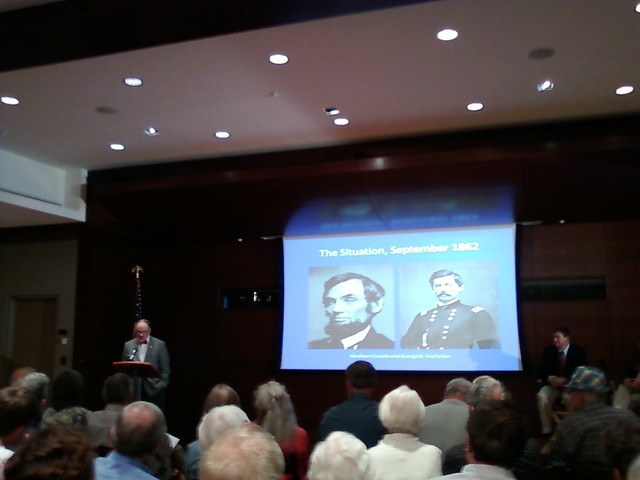 Dr. Hospodor began by quoting his Methodist minister, who claimed you should ‘talk for ten minutes and make one point.’ Since he had six points to make and only ten minutes to do it in, he proclaimed himself doomed.
Dr. Hospodor began by quoting his Methodist minister, who claimed you should ‘talk for ten minutes and make one point.’ Since he had six points to make and only ten minutes to do it in, he proclaimed himself doomed.
Dr. Hospodor began his Union response with some background on George McClellan, appointed by Abraham Lincoln and taking command of the Union forces. He described McClellan as überconfident, who inherited ‘a heck of a problem’ and accomplished a miracle reorganization of the Union army, likening those forces to a heavy weight boxer. Conversely, he characterized Lee’s forces to be more like a welter weight.
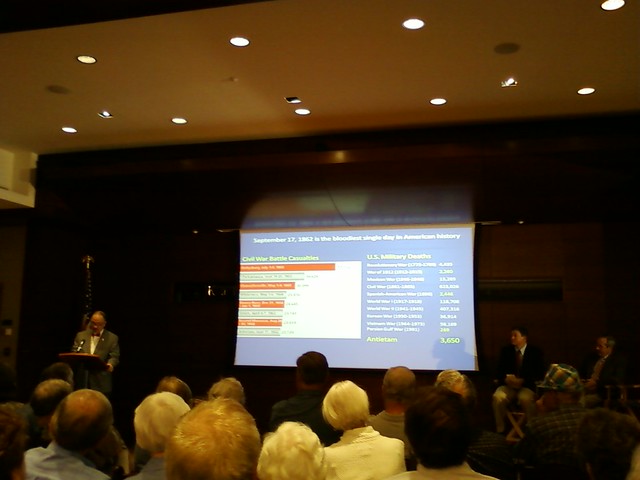 One of the biggest ‘what ifs’ from the Battle of Antietam remains why one-third of the Union army remained unengaged. After Antietam, too much blood had been shed for conciliation between the North and the South, and marked the end of the beginning of the American Civil War.
One of the biggest ‘what ifs’ from the Battle of Antietam remains why one-third of the Union army remained unengaged. After Antietam, too much blood had been shed for conciliation between the North and the South, and marked the end of the beginning of the American Civil War.
Effectively Changing the Nature of the Civil War
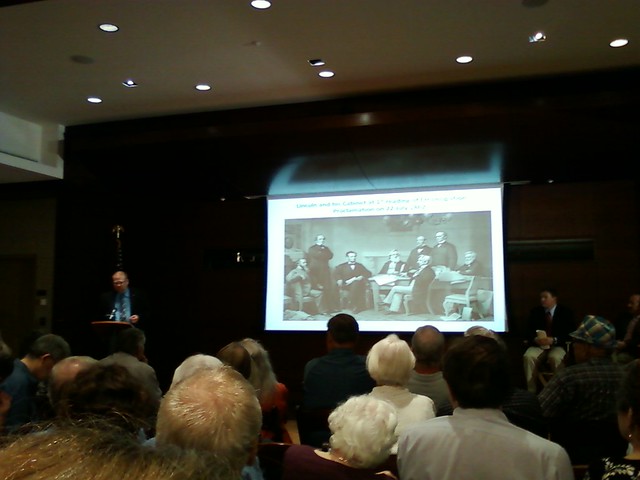 Terry Beckenbaugh enlightened us about the important political results reaped from the Battle of Antietam, specifically the Emancipation Proclamation. Why did Lincoln do it? He was personally anti-slavery, but not really an abolitionist. The Proclamation was read privately to his cabinet in July, two months before it was revealed publicly. Some of the precursors included:
Terry Beckenbaugh enlightened us about the important political results reaped from the Battle of Antietam, specifically the Emancipation Proclamation. Why did Lincoln do it? He was personally anti-slavery, but not really an abolitionist. The Proclamation was read privately to his cabinet in July, two months before it was revealed publicly. Some of the precursors included:
- 7/9/1861 – a non-binding resolution from the House of Representatives
- 8/1861 – 1st Confiscation Act
- 3/13/1862 – Act Prohibiting Return of Slaves
- 4/16/1862 – Slavery abolished in District of Columbia, which Lincoln actually signed into law
- 6/19/1862 – Exclude slavery from U.S. Territories
- 7/17/1862 – 2nd Confiscation Act
- 7/22/1862 – Reading of preliminary Emancipation Proclamation to Cabinet
Lincoln’s Secretary of State urged him to wait for a victory in the eastern theater before announcing the Proclamation. Antietam provided that victory and five days later Lincoln revealed it. However, it took the 13th Amendment to abolish slavery in non-Confederate states, the logic being that the rebelling Southern states equated to martial law and fell under the jurisdiction of the Emancipation Proclamation.
Terry affirmed the Emancipation Proclamation was first and foremost a military measure and was undeniably effective in changing the nature of the Civil War. The British worried the Proclamation would incite a race war and almost intervened in the Civil War because of it.
Questions and Answers
Ethan Rafuse returned to the podium and called for questions from the audience.
Q. After Sunker road was breached, had McClellan committed his reserves, …
A (Hospodor). Definitely a missed opportunity to end the war. Six thousand uncommitted troops could have been marched into Sharpsburg.
A (Bowie). Lot of stragglers for Confederate Army (35-40,000). Lee expected an attack. Remember, this was Lee’s only tactical engagement. There was also confusion because half of Hill’s men were wearing blue uniforms because they had stumbled upon some Union supply wagons and replaced their raggedy uniforms with fresh new blue ones. Lee was a fighting man and when his back was against a well, there was no stopping him unless you knocked him out.
Q. Quote from a USA Today article (from the 9/17/2012) … never understood why Union never forded the creek.
A (Rafuse). I be he didn’t wade it under fire. West Point cadets actual wade that creek, which is surrounded by high bluffs and steep banks. They didn’t just have to wade across, they needed to get wagons across, hence the need for the bridge. Once across, the soldiers needed to get away from the creek (out of the draw) quickly. Also, we don’t know the condition of the creek in 1862.
Q. More about McClellan
A (Hospodor). The relationship between Lincoln and McClellan strained. McClellan considered Lincoln an amateur and himself a professional talented military expert. Lincoln offended McClellan’s sensibilities, often treating the President with disdain and contempt.
Q. Talk about Frederick Douglas‘ influence on Lincoln.
A (Beckenbaugh). Lincoln came under immense pressure publicly, through Douglas’ speeches and newspapers. Lincoln understood Douglas’ frustration and not resentful of the pressure.
Have Faith
Ethan Rafuse closed the question time by bringing us back full circle to Wilder Dwight’s letter to his mother.
Dearest mother,
I am wounded so as to be helpless. Good bye if so it must be.
I think I die in victory. God defend our country. I trust in
God & love you all to the last.Dearest love to father & all my dear brothers.
Our troops have left the part of the field where I lay —
Mother, yrs
WilderAll is well with those that have faith.
Wilder Dwight died two days later and his brother, William, notified the family.
Mr. Rafuse thanked everyone for attending and encouraged the audience to approach the panelists if they had more questions.
∞∞∞
I stood up as soon as I could so I could get the blood flowing back into my legs. I planned to wait and let the rest of the audience fight for elevator space. I needed to speak to one or two of the panelists, as I did not catch their last names during the introductions. I hoped to acquire their business cards if possible. Dr. Hospodor kindly and clearly wrote his name on the back of his printed presentation slides and gave me the sheet of paper, since he didn’t have any business cards on him at the time. Terry Beckenbaugh did exchange cards with me, but I failed to catch either Rafuse or Bowie before they slipped away.
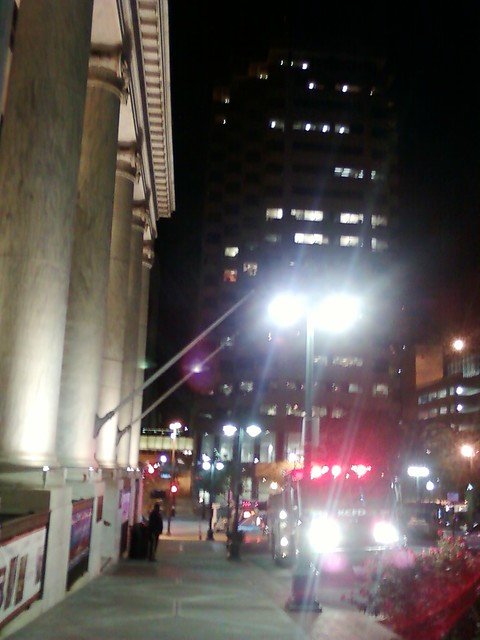
I visited the exhibits on the first floor before departing the Central Library building. As I exited the building, a firetruck and an ambulance arrived. I did not tarry to satisfy my curiosity. The Library had seemed quiet and peaceful while I had been touring the special exhibits after the lecture concluded. I walked across the street to the parking garage and began the journey home to Lansing. I enjoyed a beautiful thin sliver of the new moon most of the way west, until I exited I-70 and headed north on K-7. I even took a couple of minutes to run the van through a car wash.
I pulled in the driveway at a quarter past nine o’clock and decided Apollo needed a walk, as did my aching back. Twenty minutes later we both felt better and ready for a good night’s sleep.
